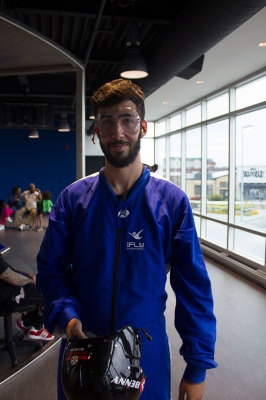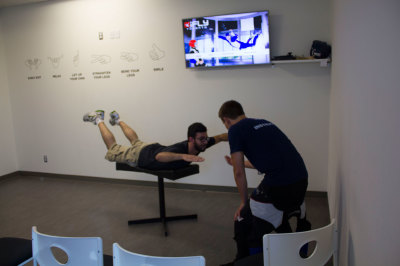Throwing caution into the wind, Sheridan Sun falls for iFly
STORY BY FILIPE DOS SANTOS
PHOTOS BY AMANDA SPILKER
I stood in the doorway without a parachute, not sure whether I was scared or excited. The wind was deafening, and then I fell.
Luckily for me it wasn’t out of an airplane, instead it was into the hands of an iFly indoor skydiving instructor.
Since mid-May people from Oakville and the rest of the GTA have been travelling to iFly Toronto’s indoors skydiving location for a chance at free falling without having to leave the ground.
According to Melanie Guerin, vice-president of iFly Toronto, people have been coming in droves to try out the first facility of its kind in Ontario.
“We get about 50 to 60 people a day throughout the week, and around 200 to 300 on weekends,” Guerin said.
After experiencing it firsthand it’s not hard to see why.
When you first head into the wind tunnel the main thing you notice is the massive amount of noise generated by the four 10-foot diameter fans that keep you in the air. The second thing you notice is how fragile and at the mercy of the elements the human body really is.
I’d never experienced anything like it.
When you get in the wind tunnel, although the wind is pushing you up, it feels like you’re in an endless free-fall, as equally terrifying as it is exciting.
After the initial shock of continuous falling dissipated and my instructor made sure I was in the right position, I tried to “fly” around a little. Every little movement resulted in a major flight change.
Before heading into the tunnel I was given a quick lesson by my instructor, Fred Poulin.
The lesson itself was simple but covered the basics of skydiving. Wind resistance, surface area, positioning and the sign language to communicate inside the tunnel, there was even a four-minute video.
After that I had to demonstrate what I had learned by laying down face first on a bench, back arched and arms and legs outstretched as if I was already falling.
The lesson ended with Poulin showing me how to properly fall into the wind tunnel holding both hands against my chest.
“The key is to relax. Not just mentally, but physically too,” Poulin said. “Although sometimes it’s much easier said than done.”
It was definitely easier said done, and while I was in there I completely forgot the sign language. It didn’t make much of a difference in the end though.
The instructors there don’t skip a beat. Poulin constantly corrected my positioning and for the most part saved me from myself.
The introductory package at iFly includes two 60-second flights for around $80, and although a little pricey, it is a must-try activity for any adrenaline junkie.






